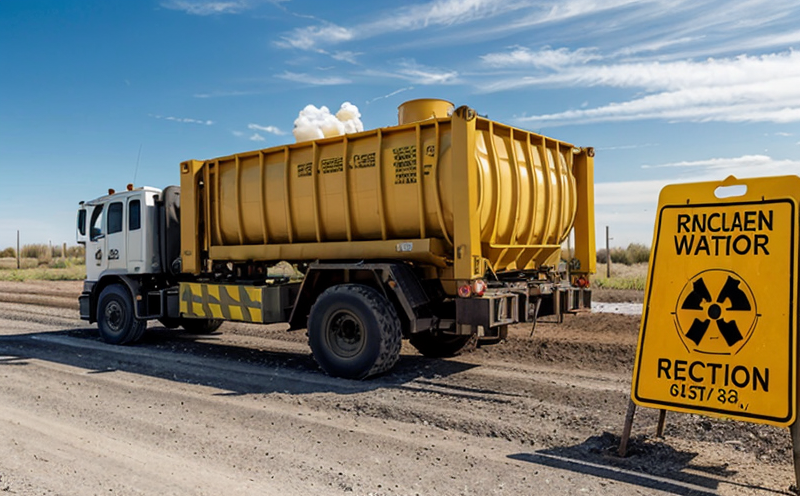ASTM C1562 Actinide Content in Nuclear Waste by Alpha Spectroscopy
The ASTM standard method ASTM C1562 provides a precise technique for determining the actinide content in nuclear waste materials using alpha spectroscopy. This service is crucial for ensuring regulatory compliance, optimizing waste management processes, and enhancing safety protocols within the nuclear industry.
The process involves several key steps: sample preparation, analysis through alpha spectrometry, and calculation of actinide concentrations. Sample preparation includes grinding the waste material to a fine powder, followed by dissolution in nitric acid. The resulting solution is then filtered and analyzed using an alpha spectrometer, which measures the energy levels associated with alpha particles emitted from the actinides.
ASTM C1562 emphasizes the importance of standardizing sample preparation methods to ensure consistent results across different laboratories. This includes precise control over the dissolution process and thorough filtration to remove interfering elements. The method also specifies the use of reference materials to calibrate the spectrometer, ensuring accurate measurements.
The actinide content is determined by comparing the measured alpha particle energies with known standards. This approach allows for quantitative analysis of specific actinides such as uranium (U), plutonium (Pu), and neptunium (Np). The results are reported in terms of weight percentage, which provides valuable insights into the composition of the nuclear waste.
The precision and accuracy of ASTM C1562 make it an indispensable tool for quality managers, compliance officers, R&D engineers, and procurement teams involved in nuclear waste management. By adhering to this standard, laboratories can ensure that their testing methods are reliable and reproducible, thereby enhancing the overall safety and efficiency of nuclear operations.
The ASTM C1562 method is widely recognized for its robustness and reliability, making it a preferred choice among regulatory bodies and industry stakeholders. Its application in nuclear waste management helps to safeguard public health and the environment by providing accurate data on actinide concentrations, which are critical for proper disposal and treatment.
Compliance with ASTM C1562 is essential for facilities handling radioactive materials, as it ensures that all testing procedures meet international standards. This standardization not only enhances credibility but also facilitates seamless integration into larger regulatory frameworks.
Industry Applications
| Application | Description |
|---|---|
| Nuclear Waste Disposal | Ensuring safe disposal by quantifying actinide content. |
| Radiation Safety Assessments | Evaluating the levels of radioactive materials in waste streams. |
| Environmental Monitoring | Tracking the environmental impact of nuclear waste management practices. |
| Research and Development | SUPPORTING new methods for treating and managing radioactive materials. |
The ASTM C1562 method finds extensive application in various sectors, including nuclear power plants, decommissioning facilities, and research institutions. By accurately determining actinide content, this standard helps these entities meet stringent regulatory requirements while ensuring the safe handling of radioactive materials.
Competitive Advantage and Market Impact
Adhering to ASTM C1562 provides significant competitive advantages in the nuclear waste management sector. Laboratories that offer this service can differentiate themselves by providing reliable, accurate, and consistent results. This not only enhances client trust but also ensures compliance with international standards.
The demand for radioactive waste testing is driven by increasing regulatory scrutiny and a growing emphasis on environmental sustainability. By offering ASTM C1562-compliant services, laboratories can cater to the needs of diverse clients, including nuclear power companies, government agencies, and research institutions. This broad client base strengthens market position and fosters long-term relationships.
The precision and reliability of ASTM C1562 testing also contribute to enhanced safety measures within the nuclear industry. By providing accurate actinide content data, laboratories can support more informed decision-making processes, leading to improved operational efficiency and reduced risks.
Use Cases and Application Examples
ASTM C1562 is widely used in various nuclear waste management scenarios. For instance, it is employed during the decommissioning of nuclear reactors to accurately quantify actinide content in the resulting debris. This information is crucial for planning appropriate disposal methods.
In research settings, ASTM C1562 helps scientists develop new techniques for treating and managing radioactive materials. By providing precise data on actinide concentrations, this standard facilitates the evaluation of different treatment processes.
Environmental monitoring programs also benefit from ASTM C1562 testing. These programs track the environmental impact of nuclear waste management practices by quantifying actinides in soil, water, and air samples. This information is essential for assessing compliance with environmental regulations and identifying potential areas of concern.





